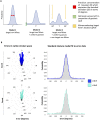Memory precision of object-location binding is unimpaired in APOE ε4-carriers with spatial navigation deficits
- PMID: 33987536
- PMCID: PMC8108563
- DOI: 10.1093/braincomms/fcab087
Memory precision of object-location binding is unimpaired in APOE ε4-carriers with spatial navigation deficits
Abstract
Research suggests that tests of memory fidelity, feature binding and spatial navigation are promising for early detection of subtle behavioural changes related to Alzheimer's disease. In the absence of longitudinal data, one way of testing the early detection potential of cognitive tasks is through the comparison of individuals at different genetic risk for Alzheimer's dementia. Most studies have done so using samples aged 70 years or older. Here, we tested whether memory fidelity of long-term object-location binding may be a sensitive marker even among cognitively healthy individuals in their mid-60s by comparing participants at low and higher risk based on presence of the ε4-allele of the apolipoprotein gene (n = 26 ε3ε3, n = 20 ε3ε4 carriers). We used a continuous report paradigm in a visual memory task that required participants to recreate the spatial position of objects in a scene. We employed mixture modelling to estimate the two distinct memory processes that underpin the trial-by-trial variation in localization errors: retrieval success which indexes the proportion of trials where participants recalled any information about an object's position and the precision with which participants retrieved this information. Prior work has shown that these memory paradigms that separate retrieval success from precision are capable of detecting subtle differences in mnemonic fidelity even when retrieval success could not. Nonetheless, Bayesian analyses found good evidence that ε3ε4 carriers did not remember fewer object locations [F(1, 42) = 0.450, P = 0.506, BF01 = 3.02], nor was their precision for the spatial position of objects reduced compared to ε3ε3 carriers [F(1, 42) = 0.12, P = 0.726, BF01 = 3.19]. Because the participants in the sample presented here were a subset of a study on apolipoprotein ε4-carrier status and spatial navigation in the Sea Hero Quest game [Coughlan et al., 2019. PNAS, 116(9)], we obtained these data to contrast genetic effects on the two tasks within the same sample (n = 33). Despite the smaller sample size, wayfinding deficits among ε3ε4 carriers could be replicated [F(1, 33) = 5.60, P = 0.024, BF10 = 3.44]. Object-location memory metrics and spatial navigation scores were not correlated (all r < 0.25, P > 0.1, 0 < BF10 < 3). These findings show spared object-location binding in the presence of a detrimental apolipoprotein ε4 effect on spatial navigation. This suggests that the sensitivity of memory fidelity and binding tasks may not extend to individuals with one ε4-allele in their early to mid-60s. The results provide further support to prior proposals that spatial navigation may be a sensitive marker for the earliest cognitive changes in Alzheimer's disease, even before episodic memory.
Keywords: APOE; Alzheimer’s disease; early detection; memory; spatial navigation.
© The Author(s) (2021). Published by Oxford University Press on behalf of the Guarantors of Brain.
Figures




Similar articles
-
Toward personalized cognitive diagnostics of at-genetic-risk Alzheimer's disease.Proc Natl Acad Sci U S A. 2019 May 7;116(19):9285-9292. doi: 10.1073/pnas.1901600116. Epub 2019 Apr 23. Proc Natl Acad Sci U S A. 2019. PMID: 31015296 Free PMC article.
-
Association between white matter hyperintensity severity and cognitive impairment according to the presence of the apolipoprotein E (APOE) ε4 allele in the elderly: retrospective analysis of data from the CREDOS study.J Clin Psychiatry. 2012 Dec;73(12):1555-62. doi: 10.4088/JCP.12m07702. Epub 2012 Oct 30. J Clin Psychiatry. 2012. PMID: 23146133
-
Evidence for Reduced Autobiographical Memory Episodic Specificity in Cognitively Normal Middle-Aged and Older Individuals at Increased Risk for Alzheimer's Disease Dementia.J Int Neuropsychol Soc. 2018 Nov;24(10):1073-1083. doi: 10.1017/S1355617718000577. Epub 2018 Aug 23. J Int Neuropsychol Soc. 2018. PMID: 30136918 Free PMC article.
-
Strategy or symptom: Semantic clustering and risk of Alzheimer's disease-related impairment.J Clin Exp Neuropsychol. 2020 Oct;42(8):849-856. doi: 10.1080/13803395.2020.1819964. Epub 2020 Sep 15. J Clin Exp Neuropsychol. 2020. PMID: 32933358
-
Getting LOST: A conceptual framework for supporting and enhancing spatial navigation in aging.Wiley Interdiscip Rev Cogn Sci. 2024 Mar-Apr;15(2):e1669. doi: 10.1002/wcs.1669. Epub 2023 Nov 7. Wiley Interdiscip Rev Cogn Sci. 2024. PMID: 37933623 Free PMC article. Review.
Cited by
-
Translating spatial navigation evaluation from experimental to clinical settings: The virtual environments navigation assessment (VIENNA).Behav Res Methods. 2024 Mar;56(3):2033-2048. doi: 10.3758/s13428-023-02134-0. Epub 2023 May 11. Behav Res Methods. 2024. PMID: 37166580 Free PMC article.
-
The APOE4 effect: structural brain differences in Alzheimer's disease according to the age at symptom onset.Eur J Neurol. 2023 Mar;30(3):597-605. doi: 10.1111/ene.15657. Epub 2022 Dec 20. Eur J Neurol. 2023. PMID: 36463489 Free PMC article.
-
Demands on perceptual and mnemonic fidelity are a key determinant of age-related cognitive decline throughout the lifespan.J Exp Psychol Gen. 2024 Jan;153(1):200-223. doi: 10.1037/xge0001476. J Exp Psychol Gen. 2024. PMID: 38236240 Free PMC article.
-
Virtual Reality and Serious Videogame-Based Instruments for Assessing Spatial Navigation in Alzheimer's Disease: A Systematic Review of Psychometric Properties.Neuropsychol Rev. 2025 Mar;35(1):77-101. doi: 10.1007/s11065-024-09633-7. Epub 2024 Feb 26. Neuropsychol Rev. 2025. PMID: 38403731 Free PMC article.
-
No effect of apolipoprotein E polymorphism on MRI brain activity during movie watching.Brain Neurosci Adv. 2025 Jan 31;9:23982128251314577. doi: 10.1177/23982128251314577. eCollection 2025 Jan-Dec. Brain Neurosci Adv. 2025. PMID: 39896129 Free PMC article.
References
-
- Chetelat G, Villemagne VL, Bourgeat P, et al.; Australian Imaging Biomarkers and Lifestyle Research Group. Relationship between atrophy and beta-amyloid deposition in Alzheimer disease. Ann Neurol. 2010;67(3):317–324. - PubMed
Grants and funding
LinkOut - more resources
Full Text Sources
Other Literature Sources
Miscellaneous
